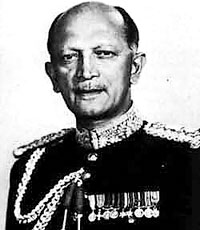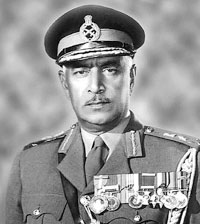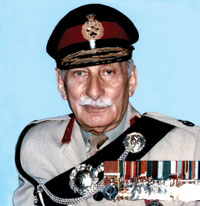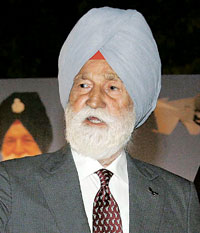INDIAN ARMED FORCES CHIEFS ON
OUR RELENTLESS AND FOCUSED PUBLISHING EFFORTS

SP Guide Publications puts forth a well compiled articulation of issues, pursuits and accomplishments of the Indian Army, over the years

I am confident that SP Guide Publications would continue to inform, inspire and influence.

My compliments to SP Guide Publications for informative and credible reportage on contemporary aerospace issues over the past six decades.
- Prime Minister witnesses 'Bharat Shakti' – a Tri-Services Firing and Manoeuvre Exercise in Pokhran, Rajasthan
- Interim Defence Budget 2024-25 — An Analysis
- Union Defence budget 2024
- Prime Minister Modi Commemorates Indian Navy Day in a Grand Ceremony
- Prime Minister Modi Flies in the LCA Tejas
- New Chapter in India-Italy Defence Ties
- Airpower beyond Boundaries
Remembering some of India's finest military leaders
Field Marshal K.M.Cariappa, the first Indian Commander-in-Chief of the Indian Army
 Field Marshal Kodandera “Kipper” Madappa Cariappa was the first Indian Commander-in-Chief of the Indian Army and led the Indian forces on the Western Front during the Indo-Pakistan War of 1947.
Field Marshal Kodandera “Kipper” Madappa Cariappa was the first Indian Commander-in-Chief of the Indian Army and led the Indian forces on the Western Front during the Indo-Pakistan War of 1947.
He is among only two Indian Army officers to hold the highest rank of Field Marshal (the other being Field Marshal Sam Manekshaw). His distinguished military career spanned almost three decades, at the highest point of which, he was appointed as the Commander-in-Chief of the Indian Military in 1949.
After World War I concluded in 1918, Indian politicians at that time raised a demand to grant Indians the King’s Commission. After strict screening, Cariappa was selected for the first batch that underwent rigorous pre-commission training. In 1919, he joined the first batch of KCIOs (King’s Commissioned Indian Officers) at The Daly College at Indore and was commissioned into the Carnatic Infantry at Bombay as a Temporary Second Lieutenant.
Cariappa served in Iraq, Syria and Iran from 1941–1942 and then in Burma in 1943-1944. He spent many of his soldiering years in Waziristan. He was the first Indian Officer to be given command of a unit in 1942. By 1944, Cariappa was a Temporary Lieutenant-Colonel. After command, he volunteered to serve in 26 Division engaged in clearing the Japanese from Burma, where he was appointed an Officer of the Order of the British Empire.
In 1947, Cariappa was the first Indian who was selected to undergo a training course at Imperial Defence College, Camberly, UK on the higher directions of war. During the traumatic period of partition, he handled the division of the Indian Army and sharing of its assets between Pakistan and India, in a most amicable, just and orderly manner. He was then the Indian officer in charge of overseeing the transition.
On outbreak of war with Pakistan in 1947, he was moved as General Officer Commanding-in-Chief, Western Command and directed operations for the recapture of Zojila, Drass and Kargil and re-established a linkup with Leh. In all this, he showed tremendous energy in moving troops, against considerable odds. This ensured his elevation to the supreme post of commander in chief.
On 15 January 1949 Cariappa was appointed as the first Indian Commander-in-Chief of the Indian Army, succeeding Lieutenant General Sir Roy Bucher, who had been in the post only a year. He was displaced owing to differences with the Indian government over the invasion of Hyderabad and the operations in Kashmir. Cariappa was then instrumental in turning an imperial army into a national army.
During the 1965 war, his son K.C. Cariappa, an Indian Air Force pilot, was shot down over Pakistan by Army officer Major Zaidi. He was captured and imprisoned as a POW by him, On realising the identity of the wounded soldier at Dargil, Radio Pakistan immediately announced the safe capture of Flt Lt K.C. Cariappa. General Ayub Khan, himself contacted Field Marshal Cariappa, who was living a retired life at Mercara, his hometown, with information about his son’s safety. When General Khan offered to release his son immediately, Field Marshal is reported to have scoffed at the idea and told him to give his son no better treatment than any other POW. “He is my son no longer,” the Old Soldier is reported to have thundered. “He is the child of this country, a soldier fighting for his motherland like a true patriot. My many thanks for your kind gesture, but I request you to release all or release none. Give him no special treatment,” the Field Marshal is reported to have said.
On May 15, 1993, Field Marshal Cariappa died in Bengaluru, aged 94.
General K.S. Thimayya, distinguished soldier
 Kodendera Subayya Thimayya, was a distinguished soldier of the Indian Army who served as Chief of Army Staff from 1957 to 1961 in the crucial years leading up to the conflict with China in 1962. After the Korean War, Thimayya headed a United Nations unit dealing with the repatriation of prisoners of war. After his retirement from the Indian Army, he went on to command the United Nations peacekeeping force in Cyprus. While in Cyprus, he died of a heart attack, in 1965.
Kodendera Subayya Thimayya, was a distinguished soldier of the Indian Army who served as Chief of Army Staff from 1957 to 1961 in the crucial years leading up to the conflict with China in 1962. After the Korean War, Thimayya headed a United Nations unit dealing with the repatriation of prisoners of war. After his retirement from the Indian Army, he went on to command the United Nations peacekeeping force in Cyprus. While in Cyprus, he died of a heart attack, in 1965.
After completing school, Thimayya was sent to the Prince of Wales Royal Indian Military College, a necessary stepping stone for a commission in the Indian Army. Following his graduation from RIMC, “Timmy”, as he was affectionately known, was one of only six Indian cadets selected for further training at the Royal Military Academy, Sandhurst. He was commissioned into the British Indian Army in 1926.
Thimayya represented the country during the surrender of the Japanese in Singapore, followed by the surrender of the Japanese in the Philippines. At the ceremony of Japanese surrender in Singapore, Timmy signed on behalf of India.
He returned to India in 1947, during the Partition as member of the committee to agree to the allotment of weapons, equipment and regiments that were to remain in India, or to be allotted to Pakistan. Soon after the commission was completed, he was promoted to the rank of Major General in September 1947 and was then assigned the command of the 4th Infantry Division and also to take over the Punjab Boundary Force, dealing with the exodus and intake of refugees fleeing to their respective countries. In 1948 he was one of the active officers in the actions against the forces of Pakistan in the conflict over Kashmir. His next appointment was command of the 19th Infantry Division in Jammu and Kashmir where he succeeded in driving the raiders and the Pakistan Army out of the Kashmir Valley. Personally leading the attack in the forward-most tank, the surprise attack on Zoji La on November 1, 1948, by a brigade with Stuart Light Tanks of the 7th Light Cavalry, succeeded in driving out the entrenched raiders and Pakistan Army regulars and the eventual capture of Dras, Kargil and Leh.
He assumed charge of the Indian Army, as the 6th Chief of the Army Staff, on May 7, 1957, and he retired in May 1961.
Sam Manekshaw, the first Field Marshal
 Sam Hormusji Framji Jamshedji Manekshaw, also known as Sam Bahadur (“Sam the Brave”), was an Indian military leader who was the first Indian Army officer to be promoted to the rank of Field Marshal. His distinguished military career spanned four decades and five wars, beginning with service in the British Indian Army in World War II. Manekshaw rose to become the eighth chief of staff of the Indian Army in 1969 and under his command, Indian forces conducted victorious campaigns against Pakistan in the Indo-Pakistani War of 1971 that led to the liberation of Bangladesh in December 1971.
Sam Hormusji Framji Jamshedji Manekshaw, also known as Sam Bahadur (“Sam the Brave”), was an Indian military leader who was the first Indian Army officer to be promoted to the rank of Field Marshal. His distinguished military career spanned four decades and five wars, beginning with service in the British Indian Army in World War II. Manekshaw rose to become the eighth chief of staff of the Indian Army in 1969 and under his command, Indian forces conducted victorious campaigns against Pakistan in the Indo-Pakistani War of 1971 that led to the liberation of Bangladesh in December 1971.
Manekshaw was born in Amritsar to Parsi parents, Hormusji Manekshaw, a doctor, and his wife Heerabai, who moved to Punjab from the small town of Valsad on the Gujarat coast. After completing his schooling in Punjab and Sherwood College (Nainital) and achieving a distinction in the school certificate examination of the Cambridge Board, he asked his father to send him to London to study medicine. When his father refused to send him until he was older, in an act of rebellion Manekshaw sat the entrance examination for enrolment into the Indian Military Academy (IMA) at Dehradun. He was successful and as a result became part of the first intake of 40 cadets on October 1, 1932. He graduated from the IMA on February 4, 1934 and was commissioned as a second lieutenant in the British Indian Army (which later became the Indian Army after Independence).
After taking over as Chief of the Army Staff (COAS), at a function on June 8, 1969, to mark the centenary of Sherwood College, Manekshaw recalled that his years at the college had prepared him for war as they had taught him to live alone and independently, to fight without relent, tolerate hunger for long periods and to hate his enemy.
Manekshaw’s military career spanned four decades, from the British era and World War II, to the three wars against Pakistan and China after India’s independence in 1947. He held several regimental, staff and command assignments. Manekshaw went on to become the eighth Chief of the Army Staff, led the Indian Army successfully in a war with Pakistan and become India’s first Field Marshal.
While handling the issues relating to Partition in 1947 Manekshaw demonstrated his acumen for planning and administration, and later was able put his battle skills to use during operations in Jammu and Kashmir in 1947–48.
Marshal Arjan Singh, epitome of a military leader
 Arjan Singh, is the only officer of the Indian Air Force to be promoted to five star rank, equal to a Field Marshal, to which he was promoted in 2002.
Arjan Singh, is the only officer of the Indian Air Force to be promoted to five star rank, equal to a Field Marshal, to which he was promoted in 2002.
He was born in Lyallpur in Punjab into an Aulakh family. He was educated at Montgomery (now in Pakistan). He entered the RAF College Cranwell in 1938 and was commissioned as a pilot officer in December 1939. As a distinguished graduate of the RAF College, Singh’s portrait is now to be found on the walls of the College’s west staircase.
Arjan Singh led No. 1 Squadron, IAF into command during the Arakan campaign in 1944. He was awarded the Distinguished Flying Cross (DFC) in 1944, and commanded the IAF exhibition flight in 1945.
He was Chief of the Air Staff (CAS), from August 1, 1964, to July 15, 1969, and was awarded the Padma Vibhushan in 1965. He also became the first Air Chief Marshal of the Indian Air Force when, in recognition of the Air Force’s contribution in the 1965 war, the rank of the Chief of Air Staff was upgraded to that of Air Chief Marshal. After he retired in 1969 at the age of 50, he was appointed the Indian Ambassador to Switzerland in 1971. He concurrently served as the Ambassador to the Vatican. He was appointed High Commissioner to Kenya in 1974. He was member of the Minorities Commission, Government of India from 1975-1981. He was Lt Governor of Delhi from December 1989 to December 1990 and was made Marshal of the Air Force in January, 2002.
Marshal Arjan Singh is the epitome of a military leader.





